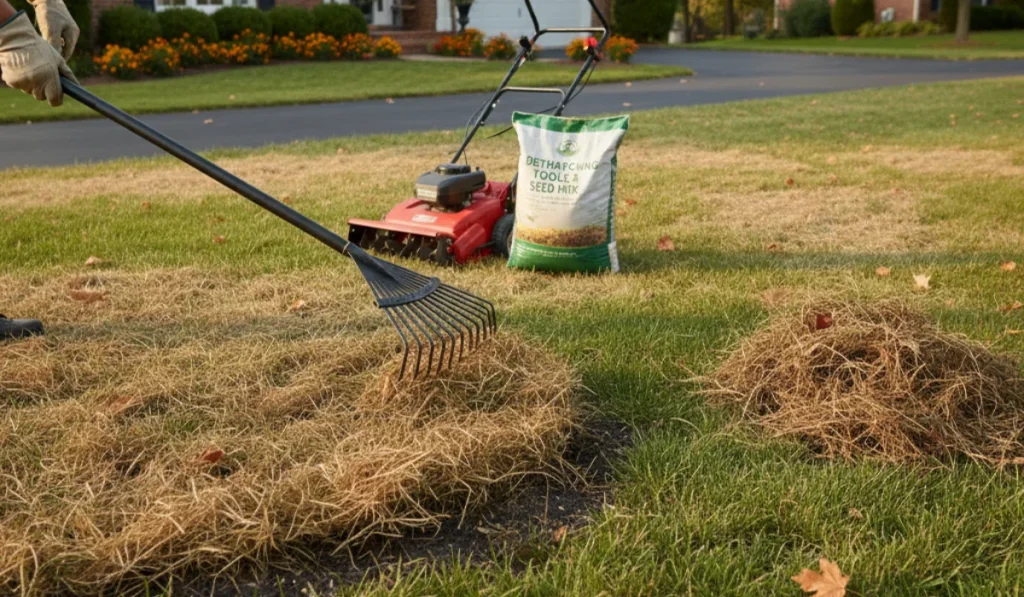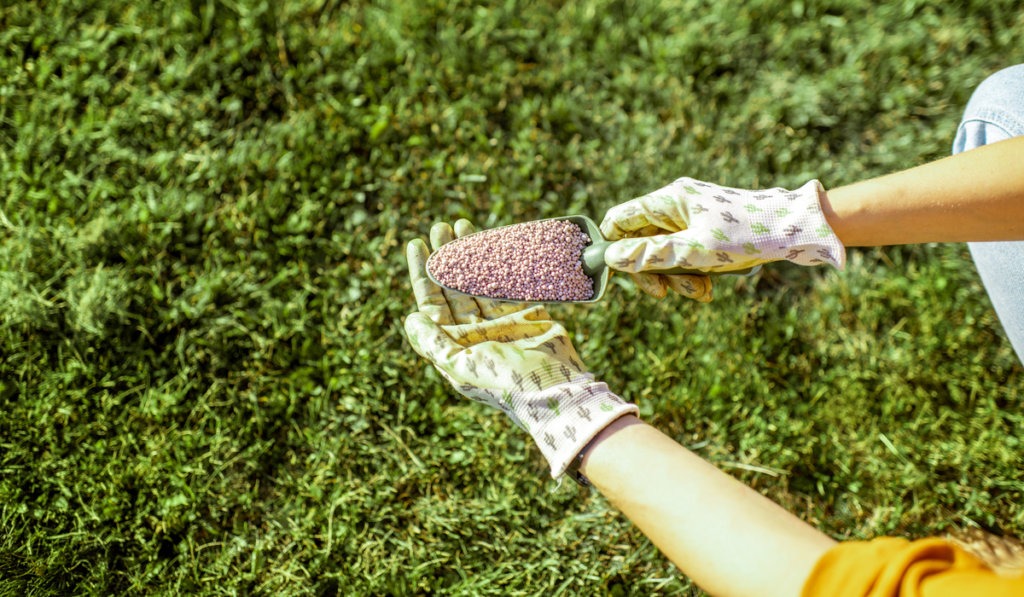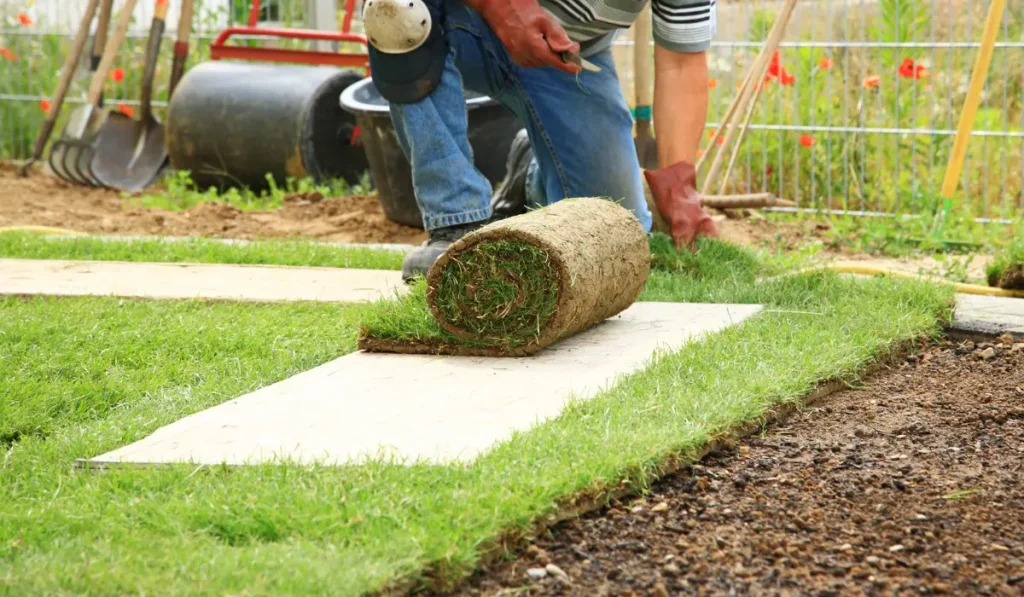Top dressing a lawn is one of those lawn care tasks that might seem intimidating at first, but once you get the hang of it, it can make a big difference in the health and appearance of your grass.
In this guide, we’ll walk you through the entire process step-by-step, covering everything from preparation to post-care so you can confidently top dress your lawn like a pro.
Key Takeaways
- A soil test helps you understand your lawn and pick the right top dressing for your soil type.
- A short mow and dethatching clear the way for aeration so nutrients can reach the root zone.
- A thin, even layer of top dressing followed by watering helps the material settle and nourish your grass.
- A well-watered lawn with overseeding and regular care will grow stronger, greener, and easier to maintain long term.
1. Perform a Soil Test to Understand Your Lawn’s Needs
Before you start hauling out your wheelbarrow and top dressing material, it’s worth doing a soil test. This will tell you what nutrients your existing soil is lacking and help you choose the right top dressing mix.
Whether you’re working with sandy soil, clay soil, or loam, knowing your soil type allows you to apply the right amendments and avoid wasting time or money.
You can get a soil test kit from your local garden center or send samples to a lab for a more detailed report.
2. Mow and Dethatch Your Lawn
For the best results, mow your lawn short—just don’t scalp it. The goal is to remove excess grass clippings and give your topdressing mix easy access to the soil surface.
After mowing, check for thatch buildup. Thatch is that layer of dead grass and roots that can sit between your grass and soil, blocking water and nutrients.
If it’s more than half an inch thick, dethatch your lawn to prevent problems. Dethatching your lawn allows the topdressing to settle evenly and reach the root zone where it can do the most good.
3. Aerate the Lawn for Better Soil Penetration
Core aeration creates small holes in the soil that allow air, water, and nutrients to reach your lawn’s roots. It also helps the top dressing material settle in better. This is especially important if you’re dealing with compacted or heavy clay soils.
It is a key part of lawn maintenance and can be done using a manual or mechanical aerator. Golf courses do this regularly for good reason—it works. Plus, the open holes help organic material and microbes blend into the soil more effectively.
4. Choose the Right Top Dressing Material
The best top dressing mix depends on your lawn’s soil condition. Common options include compost, topsoil, loam, or a blend of these. High-quality compost adds organic matter and beneficial microbes, improving poor soil.
If your lawn has low spots or a bumpy surface, a sand-heavy mix may help with lawn leveling.
- For sandy soil, adding compost can help with water retention.
- For heavy clay, mixing in loam and compost can improve drainage and soil structure.
Aim for a thin layer—about a quarter-inch thick—to avoid smothering your grass.
5. Apply the Top Dressing Evenly
This is where the real work starts. Use a compost spreader, shovel, or even your hands to distribute the material evenly across your lawn. A wheelbarrow helps with transport, and for large areas, a spreader can save time.
Once spread, use a leveling rake or the back of a landscape rake to smooth the material and work it into the grass. The goal is to cover the ground evenly without burying the grass blades.
Dressing lawn surfaces evenly helps with leveling and supports consistent growth.
6. Water the Lawn Thoroughly
After you top dress your lawn, give it a good soak. Watering helps the top dressing settle into the soil and activates the organic material. It also prevents the mix from drying out or blowing away.
This step is especially important if you’re combining top dressing with overseeding or adding grass seed to bare spots.
Keep the area moist—but not soggy—until you see new grass sprouting and your lawn looking refreshed.
7. Follow Up with Overseeding if Needed
If your lawn has bare spots or you want to thicken it up, this is a great time to overseed.
Choose grass seed that matches your existing lawn—whether it’s tall fescue, cool-season grass, or warm-season varieties. Spread the seed evenly over the top dressed area, and lightly rake it in.
The combination of fresh soil contact and moisture from watering will encourage quick germination and support new lawn growth.
8. Monitor and Maintain for Long-Term Results
Over the next few weeks, monitor your lawn closely. Avoid heavy foot traffic while the topdressing settles and any new grass establishes.
Continue with regular lawn care—watering, mowing with a sharp mower, and fertilizing as needed based on your soil test. Avoid using weed seeds or poor-quality compost, as these can undo your hard work.
With proper lawn care, it will bounce back stronger, greener, and healthier than before.
Frequently Asked Questions
How often should I top dress my lawn?
Most homeowners only need to top dress once a year. Doing it more often can smother grass or create buildup issues, especially with clay soils. Annual top dressing supports healthy growth without overwhelming your lawn’s natural balance.
Can I topdress over a lawn with moss?
Top dressing over moss won’t solve the underlying problem. Moss usually points to poor drainage, low soil pH, or heavy shade. Fix those issues first with lime, pruning, or better drainage before attempting to topdress the area.
Will topdressing fix drainage problems in my yard?
Top dressing helps with minor drainage issues but won’t fix severe problems. Persistent puddling or runoff may require grading, French drains, or professional landscaping solutions.
Use top dressing only for slight improvements to water absorption and surface smoothing.



